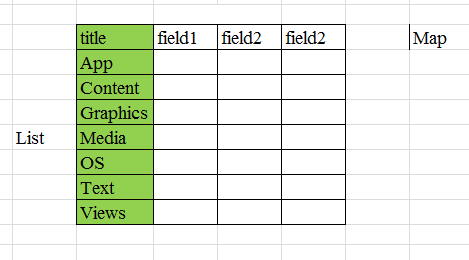編輯:Android開發實例
下面我們會以android實例來展示對應的功能,程序界面於下:
程序代碼如下,後面部分有代碼說明:
1 package com.android.messageexample;
2 import android.app.Activity;
3 import android.content.Context;
4 import android.graphics.Color;
5 import android.os.Bundle;
6 import android.os.Handler;
7 import android.os.Looper;
8 import android.os.Message;
9 import android.util.Log;
10 import android.view.View;
11 import android.view.View.OnClickListener;
12 import android.widget.Button;
13 import android.widget.LinearLayout;
14 import android.widget.TextView;
15 public class MessageExample extends Activity implements OnClickListener {
16 private final int WC = LinearLayout.LayoutParams.WRAP_CONTENT;
17 private final int FP = LinearLayout.LayoutParams.FILL_PARENT;
18 public TextView tv;
19 private EventHandler mHandler;
20 private Handler mOtherThreadHandler=null;
21 private Button btn, btn2, btn3, btn4, btn5, btn6;
22 private NoLooperThread noLooerThread = null;
23 private OwnLooperThread ownLooperThread = null;
24 private ReceiveMessageThread receiveMessageThread =null;
25 private Context context = null;
26 private final String sTag = "MessageExample";
27 private boolean postRunnable = false;
28
29 /** Called when the activity is first created. */
30 @Override
31 public void onCreate(Bundle savedInstanceState) {
32 super.onCreate(savedInstanceState);
33 context = this.getApplicationContext();
34 LinearLayout layout = new LinearLayout(this);
35 layout.setOrientation(LinearLayout.VERTICAL);
36 btn = new Button(this);
37 btn.setId(101);
38 btn.setText("message from main thread self");
39 btn.setOnClickListener(this);
40 LinearLayout.LayoutParams param =
41 new LinearLayout.LayoutParams(250,50);
42 param.topMargin = 10;
43 layout.addView(btn, param);
44 btn2 = new Button(this);
45 btn2.setId(102);
46 btn2.setText("message from other thread to main thread");
47 btn2.setOnClickListener(this);
48 layout.addView(btn2, param);
49 btn3 = new Button(this);
50 btn3.setId(103);
51 btn3.setText("message to other thread from itself");
52 btn3.setOnClickListener(this);
53 layout.addView(btn3, param);
54 btn4 = new Button(this);
55 btn4.setId(104);
56 btn4.setText("message with Runnable as callback from other thread to main thread");
57 btn4.setOnClickListener(this);
58 layout.addView(btn4, param);
59 btn5 = new Button(this);
60 btn5.setId(105);
61 btn5.setText("main thread's message to other thread");
62 btn5.setOnClickListener(this);
63 layout.addView(btn5, param);
64 btn6 = new Button(this);
65 btn6.setId(106);
66 btn6.setText("exit");
67 btn6.setOnClickListener(this);
68 layout.addView(btn6, param);
69 tv = new TextView(this);
70 tv.setTextColor(Color.WHITE);
71 tv.setText("");
72 LinearLayout.LayoutParams param2 =
73 new LinearLayout.LayoutParams(FP, WC);
74 param2.topMargin = 10;
75 layout.addView(tv, param2);
76 setContentView(layout);
77
78 //主線程要發送消息給other thread, 這裡創建那個other thread
79 receiveMessageThread = new ReceiveMessageThread();
80 receiveMessageThread.start();
81 }
82
83 //implement the OnClickListener interface
84 @Override
85 public void onClick(View v) {
86 switch(v.getId()){
87 case 101:
88 //主線程發送消息給自己
89 Looper looper;
90 looper = Looper.myLooper(); //get the Main looper related with the main thread
91 //如果不給任何參數的話會用當前線程對應的Looper(這裡就是Main Looper)為Handler裡面的成員mLooper賦值
92 mHandler = new EventHandler(looper);
93 //mHandler = new EventHandler();
94 // 清除整個MessageQueue裡的消息
95 mHandler.removeMessages(0);
96 String obj = "This main thread's message and received by itself!";
97 //得到Message對象
98 Message m = mHandler.obtainMessage(1, 1, 1, obj);
99 // 將Message對象送入到main thread的MessageQueue裡面
100 mHandler.sendMessage(m);
101 break;
102 case 102:
103 //other線程發送消息給主線程
104 postRunnable = false;
105 noLooerThread = new NoLooperThread();
106 noLooerThread.start();
107 break;
108 case 103:
109 //other thread獲取它自己發送的消息
110 tv.setText("please look at the error level log for other thread received message");
111 ownLooperThread = new OwnLooperThread();
112 ownLooperThread.start();
113 break;
114 case 104:
115 //other thread通過Post Runnable方式發送消息給主線程
116 postRunnable = true;
117 noLooerThread = new NoLooperThread();
118 noLooerThread.start();
119 break;
120 case 105:
121 //主線程發送消息給other thread
122 if(null!=mOtherThreadHandler){
123 tv.setText("please look at the error level log for other thread received message from main thread");
124 String msgObj = "message from mainThread";
125 Message mainThreadMsg = mOtherThreadHandler.obtainMessage(1, 1, 1, msgObj);
126 mOtherThreadHandler.sendMessage(mainThreadMsg);
127 }
128 break;
129 case 106:
130 finish();
131 break;
132 }
133 }
134 class EventHandler extends Handler
135 {
136 public EventHandler(Looper looper) {
137 super(looper);
138 }
139 public EventHandler() {
140 super();
141 }
142 public void handleMessage(Message msg) {
143 //可以根據msg.what執行不同的處理,這裡沒有這麼做
144 switch(msg.what){
145 case 1:
146 tv.setText((String)msg.obj);
147 break;
148 case 2:
149 tv.setText((String)msg.obj);
150 noLooerThread.stop();
151 break;
152 case 3:
153 //不能在非主線程的線程裡面更新UI,所以這裡通過Log打印收到的消息
154 Log.e(sTag, (String)msg.obj);
155 ownLooperThread.stop();
156 break;
157 default:
158 //不能在非主線程的線程裡面更新UI,所以這裡通過Log打印收到的消息
159 Log.e(sTag, (String)msg.obj);
160 break;
161 }
162 }
163 }
164 //NoLooperThread
165 class NoLooperThread extends Thread{
166 private EventHandler mNoLooperThreadHandler;
167 public void run() {
168 Looper myLooper, mainLooper;
169 myLooper = Looper.myLooper();
170 mainLooper = Looper.getMainLooper(); //這是一個static函數
171 String obj;
172 if(myLooper == null){
173 mNoLooperThreadHandler = new EventHandler(mainLooper);
174 obj = "NoLooperThread has no looper and handleMessage function executed in main thread!";
175 }
176 else {
177 mNoLooperThreadHandler = new EventHandler(myLooper);
178 obj = "This is from NoLooperThread self and handleMessage function executed in NoLooperThread!";
179 }
180 mNoLooperThreadHandler.removeMessages(0);
181 if(false == postRunnable){
182 //send message to main thread
183 Message m = mNoLooperThreadHandler.obtainMessage(2, 1, 1, obj);
184 mNoLooperThreadHandler.sendMessage(m);
185 Log.e(sTag, "NoLooperThread id:" + this.getId());
186 }else{
187 //下面new出來的實現了Runnable接口的對象中run函數是在Main Thread中執行,不是在NoLooperThread中執行
188 //注意Runnable是一個接口,它裡面的run函數被執行時不會再新建一個線程
189 //您可以在run上加斷點然後在eclipse調試中看它在哪個線程中執行
190 mNoLooperThreadHandler.post(new Runnable(){
191 @Override
192 public void run() {
193 tv.setText("update UI through handler post runnalbe mechanism!");
194 noLooerThread.stop();
195 }
196 });
197 }
198 }
199 }
200
201 //OwnLooperThread has his own message queue by execute Looper.prepare();
202 class OwnLooperThread extends Thread{
203 private EventHandler mOwnLooperThreadHandler;
204 public void run() {
205 Looper.prepare();
206 Looper myLooper, mainLooper;
207 myLooper = Looper.myLooper();
208 mainLooper = Looper.getMainLooper(); //這是一個static函數
209 String obj;
210 if(myLooper == null){
211 mOwnLooperThreadHandler = new EventHandler(mainLooper);
212 obj = "OwnLooperThread has no looper and handleMessage function executed in main thread!";
213 }
214 else {
215 mOwnLooperThreadHandler = new EventHandler(myLooper);
216 obj = "This is from OwnLooperThread self and handleMessage function executed in NoLooperThread!";
217 }
218 mOwnLooperThreadHandler.removeMessages(0);
219 //給自己發送消息
220 Message m = mOwnLooperThreadHandler.obtainMessage(3, 1, 1, obj);
221 mOwnLooperThreadHandler.sendMessage(m);
222 Looper.loop();
223 }
224 }
225
226 //ReceiveMessageThread has his own message queue by execute Looper.prepare();
227 class ReceiveMessageThread extends Thread{
228 public void run() {
229 Looper.prepare();
230 mOtherThreadHandler = new Handler(){
231 public void handleMessage(Message msg) {
232 Log.e(sTag, (String)msg.obj);
233 }
234 };
235 Looper.loop();
236 }
237 }
238
239 }
240
使用Looper.myLooper靜態方法可以取得當前線程的Looper對象。
使用mHandler = new EevntHandler(Looper.myLooper()); 可建立用來處理當前線程的Handler對象;其中,EevntHandler是Handler的子類。
使用mHandler = new EevntHandler(Looper.getMainLooper()); 可建立用來處理main線程的Handler對象;其中,EevntHandler是Handler的子類。
主線程發送消息:
在onClick的case 101中創建一個繼承自Handler的EventHandler對象,然後獲取一個消息,然後通過EventHandler對象調用 sendMessage把消息發送到主線程的MessageQueue中。主線程由系統創建,系統會給它建立一個Looper對象和 MessageQueue,所以可以接收消息。這裡只要根據主線程的Looper對象初始化EventHandler對象,就可以通過 EventHandler對象發送消息到主線程的消息隊列中。
主線程處理消息:
這裡是通過 EventHandler的handleMessage函數處理的,其中收到的Message對象中what值為一的消息就是發送給它的,然後把消息裡面附帶的字符串在TextView上顯示出來。
其他線程發送消息(這裡是說不使用Runnable作為callback的消息):
首先 postRunnable設為false,表示不通過Runnable方式進行消息相關的操作。然後啟動線程noLooerThread, 然後以主線程的Looper對象為參數建立EventHandler的對象mNoLooperThreadHandler,然後獲取一個Message並把一個字符串賦值給它的一個成員obj,然後通過mNoLooperThreadHandler把消息發送到主線程的MessageQueue中。
主線程處理消息:
這裡是通過 EventHandler的handleMessage函數處理的,其中收到的Message對象中what值為二的消息就是上面發送給它的,然後把消息裡面附帶的字符串在TextView上顯示出來。
其他線程發送消息:
其他非主線程建立後沒有自己的Looper對象,所以也沒有MessageQueue,需要給非主線程發送消息時需要建立MessageQueue以便接收消息。下面說明如何給自己建立MessageQueue和Looper對象。從OwnLooperThread的run函數中可以看見有一個 Looper.prepare()調用,這個就是用來建立非主線程的MessageQueue和Looper對象的。
所以這裡的發送消息過程是建立線程mOwnLooperThread,然後線程建立自己的Looper和MessageQueue對象,然後根據上面建立的Looper對象建立對應的EventHandler對象mOwnLooperThreadHandler,然後由mOwnLooperThreadHandler建立消息並且發送到自己的MessageQueue裡面。
其他線程處理接收的消息:
線程要接收消息需要在run函數中調用Looper.loop(),然後loop函數會從MessageQueue中取出消息交給對應的Handler對象 mOwnLooperThreadHandler處理,在mOwnLooperThreadHandler的handleMessage函數中會把 Message對象中what值為三的消息(上面發送的消息)在Log中打印出來,可以通過Logcat工具查看log。
其他線程發送消息(這裡是說使用Runnable作為callback的消息):
首先 postRunnable設為true,表示通過Runnable方式進行消息相關的操作。然後啟動線程noLooerThread, 然後以主線程的Looper對象為參數建立EventHandler的對象mNoLooperThreadHandler,然後獲取一個Message並把一個字符串賦值給它的一個成員obj,然後通過mNoLooperThreadHandler把消息發送到主線程的MessageQueue中。
主線程處理消息:
主線程收到上面發送的Message後直接運行上面Runnable對象中的run函數進行相應的操作。run函數通過Log打印一個字符串,可以通過Logcat工具查看 log。
主線程發送消息:
這裡首先要求線程receiveMessageThread運行(在onCreate函數中完成),並且准備好自己的 Looper和MessageQueue(這個通過ReceiveMessageThread中的run函數中的Looper.prepare()調用完成),然後根據建立的Looper對象初始化Handler對象mOtherThreadHandler。然後在onClick的case 105中由mOtherThreadHandler建立一個消息(消息中有一個字符串對象)並且發送到線程receiveMessageThread中的 MessageQueue中。
其他線程處理接收的消息:
線程要接收消息需要在run函數中調用Looper.loop(),然後loop函數會從MessageQueue中取出消息交給對應的Handler對象mOtherThreadHandler處理,在mOtherThreadHandler的handleMessage函數中會把Message對象中的字符串對象在Log中打印出來,可以通過Logcat工具查看log
轉自:http://www.cnblogs.com/jk1001/archive/2010/07/28/1786577.html
 Android ApiDemo示例解讀系列之二:ListActivity、SimpleAdapter和PackageManager
Android ApiDemo示例解讀系列之二:ListActivity、SimpleAdapter和PackageManager
如上一節中所講的那樣創建了ApiDemo工程後,我們就可以進行每個示例代碼的分
 Android自定義ActionBar實例
Android自定義ActionBar實例
本文實例講述了Android自定義ActionBar的實現方法。分享給大家供大家參考。具體實現方法如下: Android 3.0及以上已經有了ActionBar的
 Android圖片切換
Android圖片切換
有時候,不希望圖片突然出現在屏幕上,而要應用某種形式的動畫顯示圖片時,從一個圖像轉換到另一個。這是在Android中支持的ImageSwitcher圖像切換器允許通過它們
 Android登錄實例
Android登錄實例
登錄應用程序的屏幕,詢問憑據登錄到一些特定的應用。可能需要登錄到Facebook,微博等本章介紹了,如何創建一個登錄界面,以及如何管理安全問題和錯誤嘗試。首先,必須定義兩